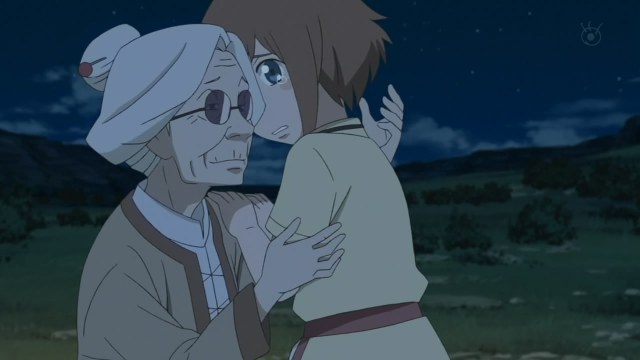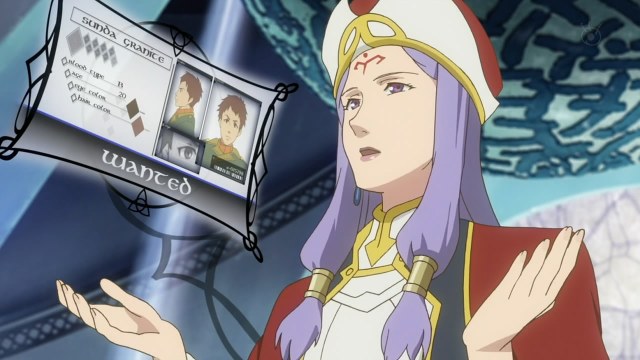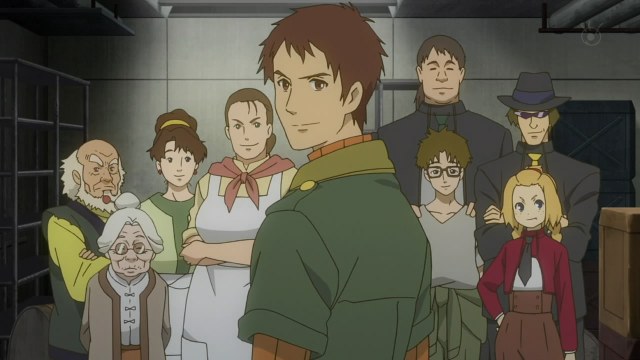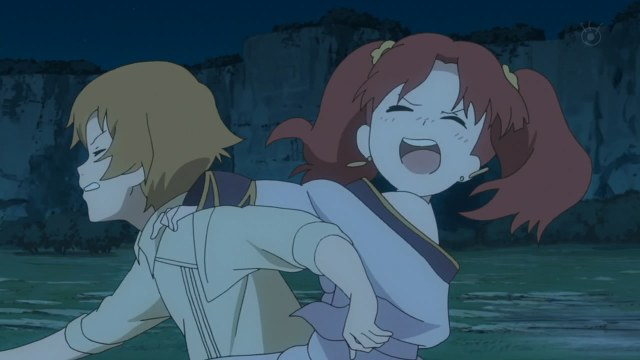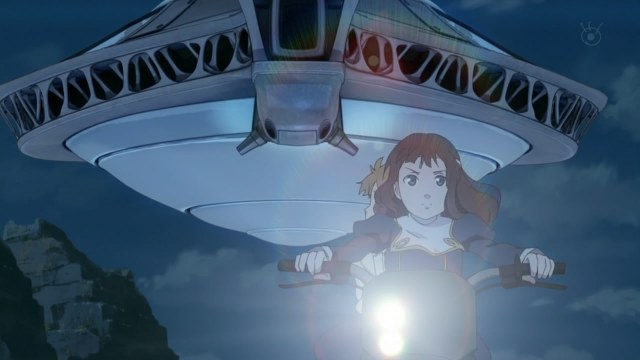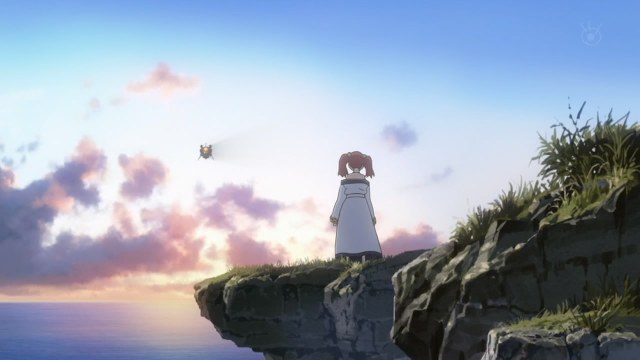After a highly eventful episode 3, it is imperative for Fractale to have an appropriate follow-up episode where the characters react to events. The standard rules of storytelling beat determine that the plot must alternate between events that happen and the reactions of the characters that experience them. In episode 4, the pace of the story continues, allowing all of the characters to get together and respond to what happened. The Lost Millennium runs from the law of the temple. Clain, Phryne and Nessa confront each other after all 3 meet together for the first time.
The two storylines continue appropriately, building up tension towards the climactic scene with Phryne and Clain, leaving us with a heavy result of Nessa refusing to follow the two after they make their escape. Let’s take a look at how the build-up of tension takes place over the scenes and evaluate the effectiveness of the resulting climax of this episode.
Scene 1
The Lost Millennium take Phryne and Claine aboard their ship amidst the chaos of the gunfight.
The opening scene takes us right back to the scene of the first reveal. In order to separate itself from the previous episode, a smooth resolution of this particular scene is important to wrap up the events of the last episode, and transition into the current one. The chaotic nature of the event itself lends well to the sudden departure of the group, justifying the scene being a tad rushed; as a result, it immediately provides tension for the next few scenes.
Scene 2
Enri and other Lost Millennium members grieve the loss of their companion, Butcher.
The dichotomy of scene construction follows that stories alternate between event and reaction scenes, and this one is a good one that responds to the death of Butcher. Not only does Enri show a bit more emotion in this scene despite the childish nature shown in the first few episodes, but it sets her up as an important representative of the Lost Millennium side of the moral conflict.
In the meantime, Clain dismisses the death entirely, due to Lost Millennium being a group of terrorists; it’s hard to take Clain’s side here due to the emotion shown by that side, but as a skeptic neutral perspective to the Lost Millennium vs. Church of Fractale conflict, it’s entirely justified.
Scene 3
Clain sneaks off to where Phryne is captured, and speaks with her. Phryne is confronted by Nessa.
Shortly after the response of Enri towards the previous scene, we have Clain and Nessa meeting Phryne, in response to her appearance in the previous episode as well. We continue with the pattern of event-response, seeing how the situation resolves itself. Clain needs to make decisions based on what happens in the events, and his decision to speak to Nessa leads to a confrontation between Nessa and Phryne.
The conflict between the two girls establishes a tension to what is expected to be the cast trio of the group. It fits well into the concept of Id, Ego, and Superego represented in these characters. Phryne, who schemed her own escape from the Fractale faction and holds to her own beliefs against the group she tries to avoid, represents the superego. Nessa, with a child-like personality, acting on her childish primitive urges, represents the Id. And Clain, who has ties towards both, and wishes to reconcile the two, acts as the Ego.
As this conflict between the two extremes is established, it’s important for the characters to resolve the tension in the most appropriate way, in order to make the most of the resulting triangle. It is especially important for the mediator, Clain, to facilitate the process of resolution. It’s interesting to see how a young boy handles such a role.
Scene 4
Sunda offers Phryne to join the Lost Millennium.
Once the reactions of both the Fractale and Main Character conflicts have been settled, the parties involved in both must decide on their next courses of action. In this scene, both conflicts are tied together again with Sunda trying to involve Phryne in his adventure, essentially ensuring that Clain and Nessa to do the same.
Keeping both conflicts in close proximity helps maintain a sense of cohesiveness, while at the same time, making the comparison between both a lot easier for the audience to grasp.
Scene 5
Butcher’s funeral back in Granites is interrupted when a man scolds Sanko for singing a temple song.
The resolution of outcomes caused by the battle at the Star Festival continues with this touching scene. When Nessa starts to sing in the background, Sanko is easily amused by it, and sings along. Considering that she is a member of the Lost Millennium, a minor conflict within the group itself arises, separating the men and the elderly/women/children.
Scene 6
The head priestess decrees the Granites family as wanted criminals.
The next scene is short, but keeps us informed on how the enemy is planning to attack the main characters. It’s not entirely necessary, but the scene weave style that the show has been following for the first few episodes allow for this. The antagonist side isn’t done too much, though, to maintain the tension of both Phryne and the Lost Millennium trying to avoid them. If we are fully aware of the Church’s movements, then the confrontations between both sides lose the element of surprise, and the impact is dampened.
Scene 7
The Granites family prepares to flee from their home city, vowing to uphold the values of the Lost Millennium.
I find it interesting to see the discussion amongst viewers regarding the morality of Lost Millennium and their beliefs. Considering that the group consists of a wide range of demographics, as well as personalities, it’s hard to paint the group in black and white terms.
Story-wise, it’s not even necessary to establish themselves as such. The only requirements for establishing conflict in the story is that the two opposing sides have differing beliefs with regards to a particular situation, and either impose their own beliefs on the other, or prevent the other side from imposing theirs.
In this case, this scene highlights the empowerment of the Lost Millennium party, directly in response to discovering the decree from Fractale in the previous scene. They affirm their own beliefs, and the solidarity between the group, rooted in the tragic demise of Butcher, allows the viewer to connect with them, despite the morality behind their actions.
Scene 8
Clain decides to rescue Phryne from the Lost Millennium, to the dismay of Nessa.
As Lost Millennium acts, so does Clain. As the mediator between Nessa and Phryne, Clain wants to be with both of them, despite the selfish demands of the girl on his back. He already has established a rapport with her from episode 2, so it is important to try and do the same with Phryne. However, because Phryne is directly tied to Fractale, his confrontation with her will result in a direct confrontation with the church as well, made evident in the next scene.
Scene 9
The temple attacks the village of Granites, turning their attention to Phryne right after. Clain confronts Phryne about running away from him. They both escape with the Lost Millennium.
The culminating scene of the episode is established with the most tension that the story can provide. The church that was set to chase after Granites in the previous scenes conveniently find Phryne, who was with Lost Millennium the entire time. Clain’s stubbornness, and his wish to reunite Nessa with Phryne, leaves him in a tense situation, confronting her in the middle of a tense chase scene between a motorcycle and a mothership of sorts.
The scenes leading up to this particular one were set up in a logical manner, allowing for this one to play out the way it did, and allowing the plot direction to continue in the most believable way possible.
Scene 11
Phryne reluctantly decides to stay with Lost Millennium. Clain stays with Phryne, but Nessa is left behind.
The confrontation between the Church of Fractale and Phryne is momentarily averted when Phryne jumps her motorcycle into the Lost Millennium’s ship. The conflict between Lost Millennium and Fractale is now tied to Phryne and Claine as well. Lost Millennium runs away, temporarily resolving the battle, but the tension between the three main characters remain.
Nessa’s words close the scene as well as the episode, punctuating everything that has happened. Not a single thing has gone Nessa’s way, and the composition of the picture above establishes a tone of abandonment, further stretching the tension between the three of them. Clain, despite his best efforts, has not resolved the conflict, and will take the responsibility of doing so in the next few episodes.
Nessa’s disappointment in this scene creates a weird feeling in the ending credits, since it brings a new perspective on the sequence, where Nessa is merely looking up at the sky from her seat. The new information we have here comes with a different context, making the mood a lot more interesting than usual.
Final Thoughts
As a follow-up to a very strong episode in episode 3, this installment was well-structured, allowing for some of the conflicts to build and develop in a logical way. The setup for the chase scene was excellently done, making for a solid episode. There is yet to be explained, and now that the group is in “run away” mode in response to Fractale, it allows for further development of relationship between not only Phryne and Clain/Nessa, but the trio with Lost Millennium.
I’ve been behind the past few weeks on account of the Rift beta, an upcoming MMORPG. I recently closed down my other World of Warcraft blog, so that I can enjoy my gaming on my own pace without needing to blog about it, such that I can focus more on this blog. Expect a bit more posts in the future, on top of the plot-analysis posts for Fractale. I’d like to do more opinion/review posts on series that I’ve seen, that doesn’t necessarily involve introspection of plot elements only. I look forward to the next couple of weeks, and will have episode 5 up soon before episode 6 is released. Until then, adieu. I shall see you again, down by the Sally Gardens.




